- Video: How To Tell If Your “CAT is PREGNANT” 7 Signs To Watch Out!
- Physiological possibility of getting pregnant
- Video: How to Recognize the Signs That a Cat Is Pregnant
- Determining the pregnancy of a cat
- Video: How to TELL if your cat is PREGNANT | 5 SIGNS that your CAT is Pregnant
- The gestation period of kittens and the weekly development of a cat's pregnancy
- Video: Cat Pregnancy Stages | Week-by-Week!
- Preparation for childbirth and lambing
- Pseudo pregnancy
- Video: HOW TO TELL IF YOUR CAT IS PREGNANT (without going to the vet): 6 Major Cat Pregnancy Symptoms
- Rate the author (3)
- Comments (4)
Cats have a well-developed maternal instinct. They themselves are able to take care of everything related to childbirth and offspring. But for the owners, this is also a special period in which you want to invest maximum affection, attention and care for the animal.
This requires a theoretical minimum: how to understand how long a cat is pregnant, its course, the process of childbirth, diet and other points.
So, how to know if a cat is pregnant - further in our article.
Video: How To Tell If Your “CAT is PREGNANT” 7 Signs To Watch Out!

Physiological possibility of getting pregnant
Heating, i.e. readiness for fertilization, among representatives. Abyssinians have 5 months, British women have a year. Outbred cats are actively looking for a sexual partner from seven to nine months, but the timing is individual.
The ability to fertilize remains until the seventh year of life. After this age, conception can occur, but veterinarians recommend spaying by this age due to the risk of complications during pregnancy and childbirth.
Signs of sexual activity:
- rolling on the floor;
- an inviting purr, sometimes with howls that weren't there before;
- assuming tense postures while stroking around the tail;
- loss of appetite.
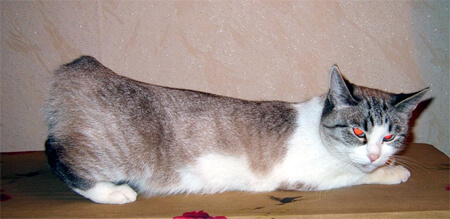
The peak of sexual activity occurs in spring and summer, but this applies only to animals that spend part of their time outside the home. Completely homemade ready for knitting all year round.
After 14 days after the completion of feeding, the cat can become a mother again. For some, this ability is retained during the period of feeding offspring.
The ability to conceive does not mean physical maturation. In young females, the pelvic bones are not yet sufficiently developed. Early pregnancy is undesirable, and if it occurs, the owners are at risk of learning what dandruff looks like in cats, since the condition will affect the skin covers, face complications during gestation and childbirth.
The optimal age for the first birth is 1.5 years. There are safe hormonal preparations for early heat, which you can consult with your veterinarian.
Video: How to Recognize the Signs That a Cat Is Pregnant

Determining the pregnancy of a cat
In domestic cats that do not go outside, controlled mating. When they show signs of estrus, they are escorted on “dates” hosts, and it is the lady who goes to the gentleman. In this case, everything is simple: two weeks after mating, the veterinarian determines the “interesting position” palpation of the abdomen and mammary glands. In the second week, the embryos are visible on ultrasound. The specialist will tell you what is the best food for a cat and give other recommendations.
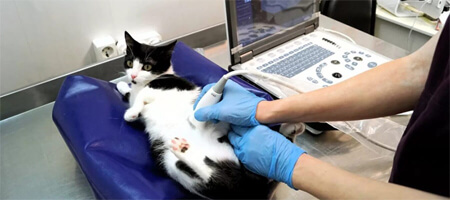
How to independently determine pregnancy in a cat at an early stage if it was not planned? Here's what you can notice in the third, fourth week:
- changing the color of the nipples from pale pink to saturated, their swelling;
- drowsiness and increased appetite, or, on the contrary, manifestations of toxicosis, when the animal is reluctant to eat;
- behavioral changes: a not too friendly animal becomes affectionate and vice versa;
- cessation of estrus after mating;
- weight gain.
At the fifth week, the cat's belly appears, first rounds, then gradually increases.
Video: How to TELL if your cat is PREGNANT | 5 SIGNS that your CAT is Pregnant

The gestation period of kittens and the weekly development of a cat's pregnancy
The duration of pregnancy depends on the breed of the animal, it is 60-74 days. Multiple “mothers” with five or more kittens in a litter are allowed earlier. The cat walks pregnant for the first time about 64 days, but it is not always possible to accurately determine the date of birth, even if the date of fertilization is known.
Stress, noise, guests can unnerve the animal and lead to premature birth.
In the process of gestation, transformations occur in the body of the future cat mother:
- 1-3 weeks: embryo formation;
- 4-6: growth of embryos. During this period, it is already possible to determine the pregnancy of a cat by its belly, and the number of kittens can be seen on ultrasound;
- 7-9 weeks: kittens acquire a full-fledged appearance, become covered with wool, weigh up to one hundred grams. It becomes difficult for the cat to walk, she plays less, tries not to jump.
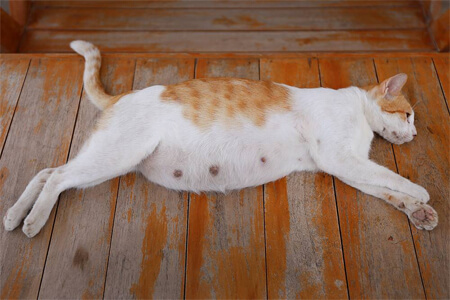
At a period of 7-9 months, kittens begin to move in a cat. Wave-like movements of the abdomen are especially noticeable when the animal is lying on its side.
Video: Cat Pregnancy Stages | Week-by-Week!

Preparation for childbirth and lambing
3-5 days before lambing begins “nesting”. The cat is on the heels of the owner, looking for a secluded place. It is better to organize it in advance, put a box with a diaper, a house, etc. But not every animal prefers a ready place for childbirth, but finds it on its own.
Immediately before childbirth, discharge from the genital tract begins, the cat licks the area under the tail. Then the contractions begin, they can last 7-8 hours, but the first kitten may appear within an hour or two after the start of the contractions.
The proverb “only cats are born quickly” is true in most cases when the health of the animal is normal. But there are exceptions, so the owner needs to study the minimum obstetric experience and prepare a veterinary first aid kit in order to help the animal if necessary. If you are afraid or the cat is giving birth for the first time, it is better to invite a veterinarian to the house.
The help of the host consists of the following activities:
- if the mother does not have time to lick the kitten, you need to carefully remove the film, wipe the baby with a sterile cloth;
- bandage the umbilical cord, cut it off, treat with an antiseptic;
- put the newborn to the mother;
- if the next kitten is not born for more than three hours, but the exact number of offspring is known, you should call the veterinarian.
Birth is considered normal if the cat is resting, and the kittens suck rhythmically and then sleep peacefully. In case of over-maturation, the viability of the fruit should be monitored.
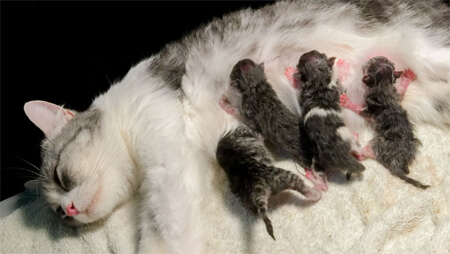
Pseudo pregnancy
False or pseudo-pregnancy is the condition of a cat in which the animal shows all the signs inherent in this condition, but it is not fertilized. The cat's nipples swell, vomiting occurs, weight increases, the belly is rounded, behavioral habits change.
False pregnancy is not a fully understood process, however, it is known that it can occur between 6 and 12 weeks of estrus and last for several months. The main reason is hormonal failure against the background of unsuccessful fertilization. There is a false pregnancy from the sight of a female who lives nearby, with diseases of the reproductive system.
Pathology can go away on its own in 2-3 weeks, but there are complications that require veterinary intervention.
Video: HOW TO TELL IF YOUR CAT IS PREGNANT (without going to the vet): 6 Major Cat Pregnancy Symptoms










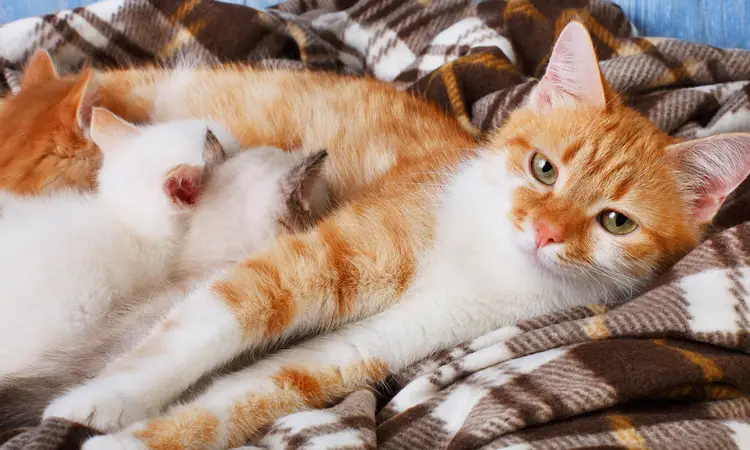





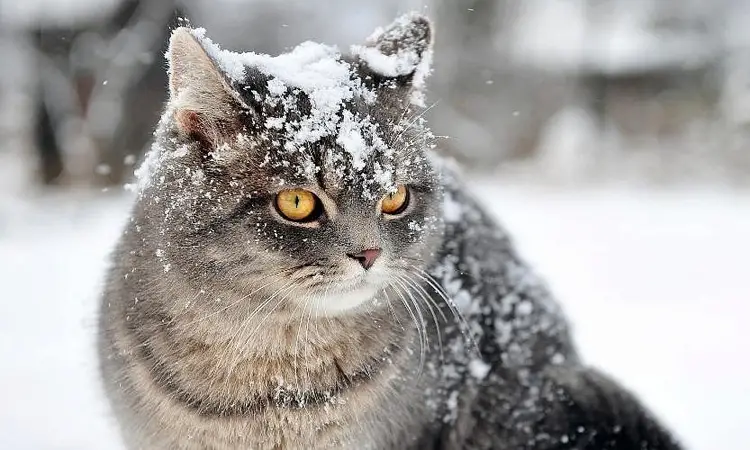
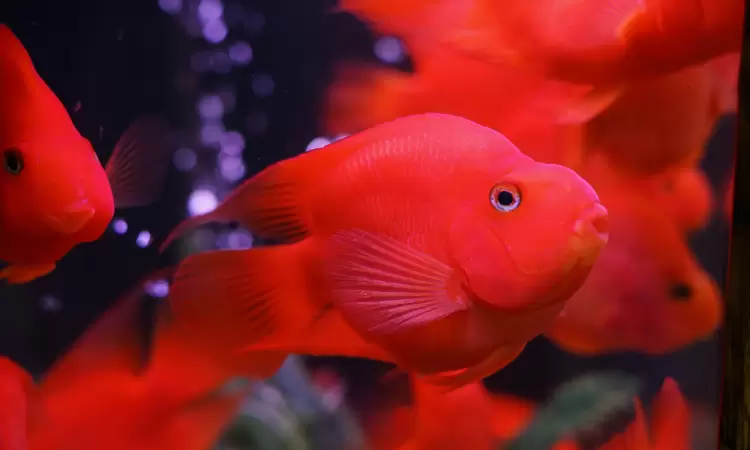
Comments (4)
1. Belly Enlargement: During pregnancy, a cat's belly gradually enlarges, especially in the last few weeks of pregnancy.
2. Changes in Behavior: Some cats may change their behavior during pregnancy. For example, they may become more affectionate or vice versa, more aggressive.
4. Changes in the teat papillae: During pregnancy, the teat papillae may become enlarged and pinkish in cats.
5. Changes in body temperature: During pregnancy, cats may experience a slight increase in body temperature.